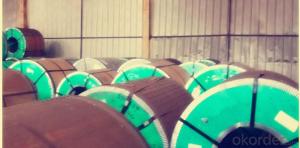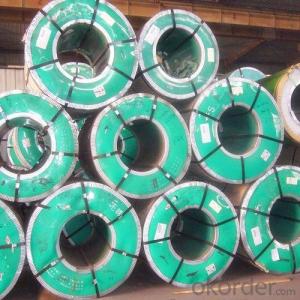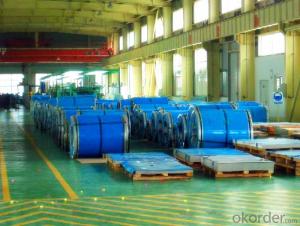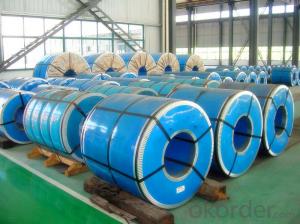Hot Rolled Stainless Steel Coil 304 Narrow Strip No.1 Finish
OKorder Service Pledge
OKorder Financial Service
You Might Also Like
Hot Rolled Stainless Steel Coil 304 Annealing and Pickling No.1 Finish Narrow Strip
1.surface:NO.1
2.standard:JIS, AISI, GB
3.width: 0.55m
Hot Rolled Stainless Steel Coil 304 Chemical Composition:
(%):C=0.07, Mn=2.00, P=0.045, S=0.030, Si=0.075, Cr=17.5-19.5, Ni=8.0-10.5, N=0.10
Hot Rolled Stainless Steel Coil 304 Physical Properties
Tensile strength σb (MPa) ≥ 520
the conditions yield strength σ0.2 (MPa) ≥ 205,
elongation δ5 (%) ≥ 40
Reduction of ψ (%) ≥ 50,
hardness: ≤ 187
HB; ≤ 90
HRB; ≤ 200H
Type | Hot Rolled Stainless Steel Coil 304 |
Thickness | 3.0mm-4.0mm |
Width | 550mm |
Length | according to weight |
Brand name | CNBM |
Standard | ASTM, AISI, DIN, GB, JIS etc |
Material | 304 |
Application | Foodstuff, Gas, metallurgy, biology, electron, chemical, petroleum, boiler, nuclear energy, Medical equipment, fertilizer etc |
Package | Standard export sea-worthy packing |
Delivery time | Within 15 days since getting the deposit or LC origin |
Surface | NO.1 |
Productivity | 20000 tons/month |
Grade: | 300 Series | Standard: | JIS,AISI,ASTM,GB,DIN,EN etc | Thickness: | 2.5mm, 3.0mm, 4.0mm |
Width: | 550mm | Length: | according to weight | Place of Origin: | China (Mainland) |
Brand Name: | CNBM | Model Number: | 304 | Technique: | Hot Rolled |
Application: | industry, construction, furniture, repairing | Certification: | MTC | Finishing: | NO.1 |
Market: | globle area | Packaged: | wooden and bags in cases as standard | Payment: | TT & LC |
Delivery time: | 15 days | MOQ: | 100 tons | Advantage: | prime quality, competitive price |
Profession: | hot rolled | Charactor: | stainless steel coils | Material/Grade: | 304 |
- Q:Can 111 stainless steel strips be coated with anti-fingerprint coatings?
- Indeed, it is possible to apply anti-fingerprint coatings on a total of 111 stainless steel strips. These coatings are specifically crafted to minimize the appearance of fingerprints and smudges on stainless steel surfaces, resulting in simplified cleaning and maintenance procedures. It is feasible to utilize this coating on different stainless steel grades, including 111 stainless steel. However, it is crucial to seek guidance from a reputable coating supplier or manufacturer to confirm the compatibility of the chosen anti-fingerprint coating with 111 stainless steel, ensuring it fulfills the desired performance criteria.
- Q:What is the difference between cold rolled and hot rolled stainless steel strips?
- Cold rolled and hot rolled stainless steel strips differ in their manufacturing processes and resulting properties. Cold rolled stainless steel strips are produced by passing the stainless steel through a series of rollers at room temperature. This process results in a thinner and more precise strip with a smooth and shiny surface finish. Cold rolling also increases the strength and hardness of the stainless steel, making it suitable for applications that require high strength and a polished appearance. Additionally, cold rolled stainless steel strips have better dimensional accuracy and straightness compared to their hot rolled counterparts. On the other hand, hot rolled stainless steel strips are manufactured by heating the stainless steel slab or billet to a high temperature and then rolling it through a series of rolling mills. This process produces a thicker and less precise strip with a rough and scaled surface finish. Hot rolling is preferred for applications that do not require a high level of precision or a polished appearance, such as structural applications or manufacturing processes that involve further shaping or forming of the stainless steel strip. In terms of properties, cold rolled stainless steel strips have higher tensile strength and yield strength compared to hot rolled strips. They also exhibit better corrosion resistance, as the cold rolling process helps to refine the microstructure of the stainless steel, reducing the presence of defects and impurities. However, hot rolled stainless steel strips have higher ductility and are more easily formable due to their higher temperature processing. Overall, the choice between cold rolled and hot rolled stainless steel strips depends on the specific application requirements, such as the desired surface finish, dimensional accuracy, strength, and formability.
- Q:Are 111 stainless steel strips resistant to scaling at elevated temperatures?
- Yes, 111 stainless steel strips are resistant to scaling at elevated temperatures. The composition and properties of 111 stainless steel make it highly resistant to oxidation and scaling when exposed to high temperatures. This type of stainless steel contains a higher percentage of chromium, which forms a protective oxide layer on the surface of the strips. This oxide layer acts as a barrier, preventing the steel from reacting with oxygen and other elements in the atmosphere. As a result, the 111 stainless steel strips maintain their integrity and resist scaling even when subjected to elevated temperatures.
- Q:Can stainless steel strips be used in marine environments?
- Yes, stainless steel strips can be used in marine environments. Stainless steel is known for its corrosion resistance properties, making it suitable for various marine applications such as shipbuilding, offshore structures, and marine equipment. The chromium content in stainless steel forms a protective passive layer on the surface, preventing corrosion caused by saltwater and other harsh environmental conditions typically found in marine environments.
- Q:Which stainless steel belt has better elasticity?
- In stainless steel strips, SUS301 has the best elasticity, and is used for springs, springs, or EH, or spring.SUS301 is the highest hardness, can be HV590 degrees, is less than SUS304. If you want to use the materials required materials SUS301 HV480.
- Q:Are stainless steel strips suitable for furnace parts?
- Yes, stainless steel strips are suitable for furnace parts. Stainless steel is known for its high resistance to corrosion, heat, and oxidation, making it an ideal material for furnace components that are exposed to extreme temperatures. The stainless steel strips provide excellent strength and durability, ensuring the longevity of furnace parts. Additionally, stainless steel's non-reactive nature makes it suitable for various types of furnaces, including those used for industrial, commercial, and residential purposes. Overall, stainless steel strips are a reliable and efficient choice for furnace parts.
- Q:Can stainless steel strips be used in food processing equipment?
- Food processing equipment can indeed make use of stainless steel strips. Within the food industry, stainless steel is a favored choice due to its numerous desirable qualities. Its exceptional corrosion resistance is particularly crucial in an environment where contact with both food and water is common. Furthermore, stainless steel is easy to clean and sanitize, making it well-suited for food processing equipment that requires frequent washing. In addition, stainless steel does not react with food, ensuring that no harmful substances are leached into the processed products. Its durability and strength also guarantee that the equipment can withstand the rigorous demands of the food processing industry. In summary, stainless steel strips are a dependable and secure option for food processing equipment.
- Q:What is the melting point of stainless steel strips?
- The melting point of stainless steel strips is subject to variation based on the specific alloy employed. Typically, the melting point of stainless steel strips falls within the range of 2,500 to 2,800 degrees Fahrenheit (1,370 to 1,540 degrees Celsius). Nevertheless, it should be emphasized that dissimilar grades or compositions of stainless steel might possess marginally diverse melting points.
- Q:Can 111 stainless steel strips be perforated for filtration applications?
- Yes, 111 stainless steel strips can be perforated for filtration applications.
- Q:What are the surface finishes available for 111 stainless steel strips?
- Some common surface finishes available for 111 stainless steel strips include mill finish, brushed finish, polished finish, and embossed finish.
1. Manufacturer Overview |
|
|---|---|
| Location | |
| Year Established | |
| Annual Output Value | |
| Main Markets | |
| Company Certifications | |
2. Manufacturer Certificates |
|
|---|---|
| a) Certification Name | |
| Range | |
| Reference | |
| Validity Period | |
3. Manufacturer Capability |
|
|---|---|
| a)Trade Capacity | |
| Nearest Port | |
| Export Percentage | |
| No.of Employees in Trade Department | |
| Language Spoken: | |
| b)Factory Information | |
| Factory Size: | |
| No. of Production Lines | |
| Contract Manufacturing | |
| Product Price Range | |
Send your message to us
Hot Rolled Stainless Steel Coil 304 Narrow Strip No.1 Finish
OKorder Service Pledge
OKorder Financial Service
Similar products
New products
Hot products
Related keywords




























